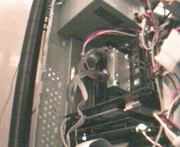|
|
|
|
 Cooling the Chips Cooling the Chips
|
|
Date Posted: Dec 24 1999
|
|
Author: Joe
|
|
|
|
|
Posting Type: Article
|
|
Category: H2O and Evap
|
|
Page: 1 of 1
|
|
Article Rank:No Rank Yet
Must Log In to Rank This Article
|
|
|
|
|
Note: This is a legacy article, imported from old code. Due to this some items on the page may not function as expected. Links, Colors, and some images may not be set correctly.
|
|
|
Cooling the Chips By: Joe
|
|
Liquid Cooling the Other components in your PC
Part 1 - 12/27/99 - Joe:
|
|
|
|
This is the first part of many to come on the topic of liquid cooling other parts of your PC besides the CPU. "Why" you ask?.. Because everyone and there grandmother has now wrote about, or is selling components to make a CPU cooler. When in all reality if you have a CPU that's running at -50C but your chipset is at +120F or your video card could cook an egg, how stable is that??. So what I am hoping to help you understand and hopefully build on these ideas to make some real bitch'n component coolers. Here are a few requirements I have found to apply to any design that cools components:
1. Slim, small - Cant fill the next PCI slot or short out the card below it, and cant be much bigger then the IC or processor you are trying to cool.
2. Light - cant be a 3 lb block of lead, it cant weight down the card to much. If it does it could ruin the PCI/AGP slot
|
|
|
|
|
|
|
|
Heres a little image of what a planned cooler will look like.
|
|
|
Click to enlarge
|
|
|
|
 |
|
|
|
|
|
3. Run off of existing cooling system - since you prolly already have coolant lines running into the case cooling your CPU, make the cooling devices capable of "T"ing off the coolant lines so you don't need to purchase new pumps, and new cooling equip.
4. Efficient - Some chips on Video cards, and chipsets can produce more heat then your CPU at times. Yet to cool a CPU people move coolant through 1/4" + tubing at over 300GPH in some cases. that would be way to big of a cooler for on a videocard. The Tubing I am looking at using is a nice 1/8" silicone tubing used in R/C car/airplane gas engines. The plate need to move heat away at a very good rate but cant be such a rate that you risk blowing lines.
5. Condensation - the formation of frost, or water on a chipset/RAM/ video card could be the kiss of death for your PC. You need to decide whether to make a "room temp" system or a system that will actually chill the chips and require some sealant work to keep frost from forming. I think for these applications, a "room temp" system would be well advised. its much easier to seal a CPU on a card slot then a video card or Ram.
Well that's about it for this quick little word on cooling, I am building and testing a few different chipset coolers and will post more parts of this article when I get some conclusive data.
Thanks and stay tuned! - Joe
|
|
|
|
| Random Forum Pic |
 |
| From Thread: is Swiftech insolvent ? |
|
| | ProCooling Poll: |
| So why the hell not? |
|
I agree!
|
 67% 67%
|
|
What?
|
 17% 17%
|
|
Hell NO!
|
 0% 0%
|
|
Worst Poll Ever.
|
 17% 17%
|
Total Votes:18Please Login to Vote!
|
|






 Cooling the Chips
Cooling the Chips
